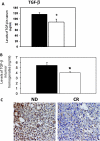Caloric restriction reduces growth of mammary tumors and metastases
- PMID: 21665891
- PMCID: PMC3165123
- DOI: 10.1093/carcin/bgr107
Caloric restriction reduces growth of mammary tumors and metastases
Abstract
We investigated the effects of caloric restriction (CR) on growth of tumors and metastases in the 4T1 mammary tumor model and found that CR, compared with normal diet, reduced the growth of mammary tumors and metastases and the total number of metastases that originated both spontaneously from the primary tumor and also experimentally from i.v. injection of the tumor cells. CR also decreased proliferation and angiogenesis and increased apoptosis in tumors. CR reduced levels of insulin, leptin, insulin-like growth factor 1, insulin-like growth factor binding protein 3 and increased adiponectin in tumors. We also demonstrated that tumors from CR mice possessed lower levels of transforming growth factor-β, lower intratumor deposition of collagen IV and reduced invasiveness due to a decrease in tumor secretion of active matrix metalloproteinase 9. Our results suggest that CR-induced metabolic and signaling changes affect the stroma and the tumor cells resulting in a microenvironment that prevents proliferation of breast tumors and their metastases.
Figures





References
-
- Bordone L, et al. Calorie restriction, SIRT1 and metabolism: understanding longevity. Nat. Rev. Mol. Cell Biol. 2005;6:298–305. - PubMed
-
- Spindler SR. Caloric restriction: from soup to nuts. Ageing Res. Rev. 2010;9:324–353. - PubMed
-
- Fu PP, et al. Caloric restriction profoundly inhibits liver tumor formation after initiation by 6-nitrochrysene in male mice. Carcinogenesis. 1994;15:159–161. - PubMed

